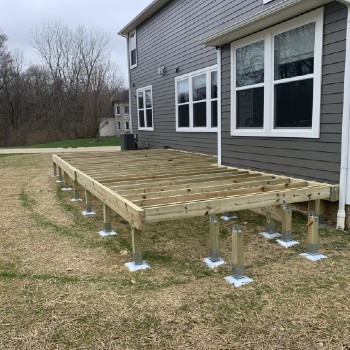
While building or recreating your deck, the well-being of every person is the highest priority. Ensure that you are using an electric tool safely. Employ someone to assist you in transporting heavy building materials and building your deck, preferably a professional like Calgary deck builders. Here is the process of creating the strongest deck.
Check required permits
Decks under a specific height are typically exempt from permission requirements in many places. Decks that are attached to a house require special approvals. Likely, this project’s detached deck does not require a building permit. Before getting started, you should research the local legislation.
Determine a Deck Spot
Mark off the deck with stakes and string. Choose a level, undisturbed area of at least 20 square feet in size. Consider how much sun and shade your deck will receive throughout the year. Set up three 12-foot-long strands of twine with stakes. Using a low stake, position the twine approximately an inch off the ground. The spacing between lines is 3.5 feet. Each line possesses a deck beam. Mark the rope with twelve dots of paint. Just one line. From a central place, please mark the following digging locations:1ft41/2ft 7.5′ 11′.Create a copy for the remaining lines. Do away with the stakes and string.
Dig Down
Hole depth should range from a few inches and one foot, depending on local requirements and deck height. Using drainage rock adds three inches to a height. The diameter of the concrete piers is 11.5 inches, while the width of the brackets is 2 1/2 inches. Create holes that are 12 inches deep. It is important that, to a depth of 3 inches, fill the holes with drainage rock. Utilize a four-by-four to pound and level the rock.
Include Piers and Install concrete supports
Using a single pier as a model, level the remaining piers. Gravel can be added or withdrawn to modify the height of the piers. Piers are leveled with laser accuracy. Additionally, the string can be used to level piers.
Place beams in brackets.
Insert a pilot drill bit into the hole in the beam where each bracket will be mounted. Insert hex-head flange screws into beams to install brackets. Instead of attaching or bolting the two-by-six boards to the beams of the deck, lay them flat. No more than a quarter-inch should exist between deck boards. Between deck boards must have a six-inch overhang. The ends of two deck boards must be flush with the timbers underneath. Overhanging planks cannot be permitted.
Attach the decking boards to the support joists.
Insert deck screws measuring three inches directly into the beams. Install two screws per connection beam and six screws per deck board. Frequent inspections must be performed on the parallelism of the boards and the 6-inch overhang. If the fasteners are concealed, the installation is less untidy. To accurately insert the screw into the deck board while using concealed fasteners, a simple jig is needed. The head of the fastener is embedded in the wood and is difficult to detect.
Preserve decking planks
Some pressure-treated wood may be left outside to weather. Invest in pressure-treated lumber to preserve the appearance of your boards. Staining and preserving deck planks will extend their lifespan. To stain and protect the wood, you only need a paint roller frame, a roller cover within a nap, and an extension pole.
